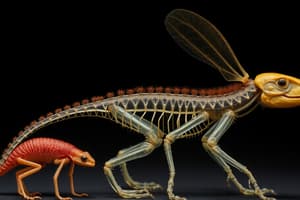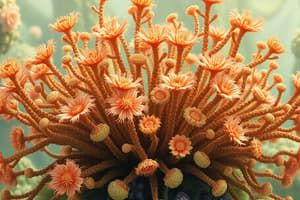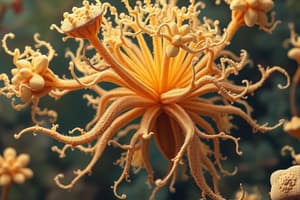Podcast
Questions and Answers
Chlorarachniophyta are exclusively marine amoeba-like protists.
Chlorarachniophyta are exclusively marine amoeba-like protists.
True (A)
Radiolaria reproduce by budding.
Radiolaria reproduce by budding.
False (B)
Entamoebas are free-living in aquatic and soil environments.
Entamoebas are free-living in aquatic and soil environments.
False (B)
Foraminifera have radial symmetry.
Foraminifera have radial symmetry.
Chlorarachniophyta have chloroplasts with 2 membranes.
Chlorarachniophyta have chloroplasts with 2 membranes.
Dictyostelium is a type of slime mold.
Dictyostelium is a type of slime mold.
Viruses are capable of replicating outside of living cells.
Viruses are capable of replicating outside of living cells.
The capsid is a lipid-containing membrane that surrounds the genetic material of a virus.
The capsid is a lipid-containing membrane that surrounds the genetic material of a virus.
Virions can be observed using a regular light microscope.
Virions can be observed using a regular light microscope.
Animal viruses have rigid nucleocapsids.
Animal viruses have rigid nucleocapsids.
All viruses have a lipid-containing membrane surrounding their nucleocapsid.
All viruses have a lipid-containing membrane surrounding their nucleocapsid.
Viruses can have either DNA or RNA genomes, but not both.
Viruses can have either DNA or RNA genomes, but not both.
Protists are a group of microscopic prokaryotic organisms.
Protists are a group of microscopic prokaryotic organisms.
Chromalveolata is a supergroup of eukarya that consists only of phototrophic species.
Chromalveolata is a supergroup of eukarya that consists only of phototrophic species.
Lysosome is responsible for the synthesis of proteins in protists.
Lysosome is responsible for the synthesis of proteins in protists.
All protists are unicellular.
All protists are unicellular.
Pellicle is a structure found in protists that is responsible for movement.
Pellicle is a structure found in protists that is responsible for movement.
Naegleria fowleri is a type of protist that is not pathogenic to humans.
Naegleria fowleri is a type of protist that is not pathogenic to humans.




